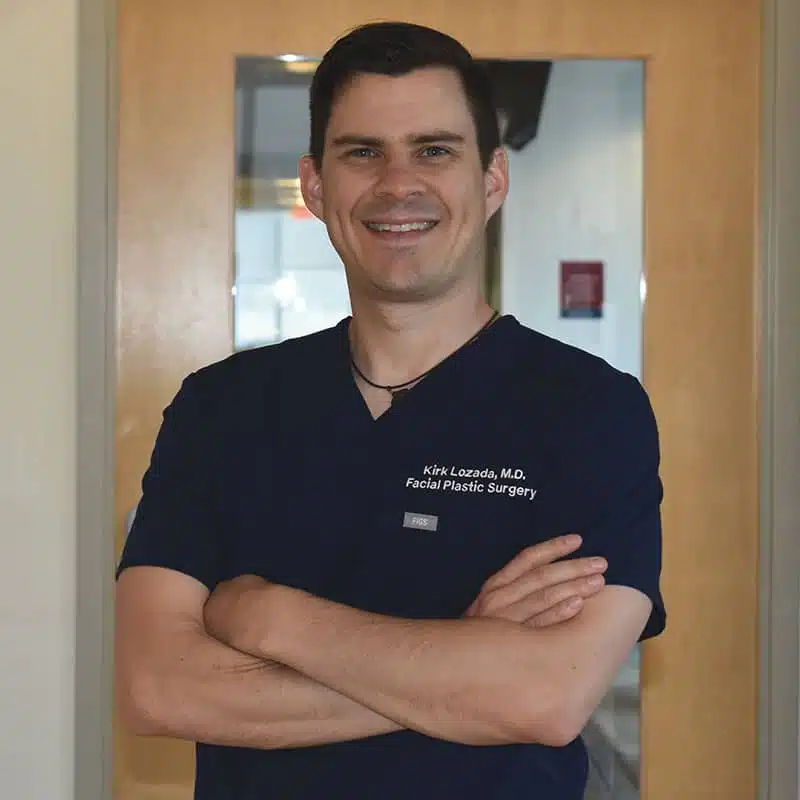
Facelift in Philadelphia, PA
Facelift surgery—or a rhytidectomy—lifts and rejuvenates the lower face and neck, primarily to address excess skin. Facelift surgery restores the face and neck back to a more youthful appearance. Dr. Lozada, an experienced plastic surgeon, uses the most advanced techniques to achieve natural results that never look “pulled” or “done.” If you live in Philadelphia, PA, call (267) 817-4600 to schedule a consultation.
Turn the Clock Back with a Facelift
In the dance of time, facial skin can lose its luster. Our signature facelift rewinds time, bringing back the youthful glow you once had. This personalized approach is tailored to your specific needs. It will rejuvenate your appearance while preserving your unique charm.
Before and After Facelift Photos
* All patients are unique and individual results may vary.

What is a Facelift?
Facelift surgery, also called a rhytidectomy, is a type of surgery that lifts and rejuvenates the lower face and neck. As we age, the skin, fat, and muscles begin to lose their skin elasticity and tone and begin to sag. This causes the well-known signs of aging, including longer jowls, deepener nasolabial folds, and sagging skin in the neck.
The options for a cosmetic procedure include a traditional facelift, a mini-facelift, and a liquid facelift, each with its unique benefits. These facelift options are designed to address your individual needs and preferences. Understanding the benefits of facelift surgery and the cost of facelift surgery will help you to make an informed decision.
Why Choose Facelift?
Facelift surgery is the most effective way to turn the clock back and restore your cheeks, jawline, and neck to a more youthful and refreshed appearance. Minimally invasive treatments can lead to some degree of skin tightening, but nothing equals what can be done with a well-executed facelift.
Are You a Candidate for a Facelift?
If you are considering a facelift, it’s essential to evaluate several factors to determine if it’s the right choice for you. Your overall health, expectations, and lifestyle play crucial roles in this decision.
- Health: Your skin should be healthy, supple, and flexible. Excessive sun exposure without protection can harm your skin, so maintaining good skin health is vital. If you are bothered by sagging cheeks, jowls, and neck skin, and you’ve ever pulled back your face and neck skin and wished for that look, a facelift might be a good option.
- Expectations: Having realistic expectations is also important. A facelift can make you look like a younger version of yourself, but it won’t transform you into a different person. Understanding this will help you appreciate the natural, rejuvenating effects of the surgery.
- Lifestyle: Your lifestyle, especially smoking habits, can impact the results. Smoking increases skin pigmentation, makes it dull and dry, and causes sagging and wrinkles, making you a less ideal candidate for a facelift. Quitting smoking can improve your skin’s health and enhance the surgery’s outcome.
Facelift surgery is suitable even for those in their 40s, as it can take years off your appearance and help you age gracefully into the next decade. Dr. Lozada will verify if you are an ideal candidate based on these criteria, ensuring you get the best possible results.

Need more information?
Call us or email us to make an appointment
Different Facelift Techniques
Dr. Lozada performs 3 techniques for his facelift surgeries.
SMAS facelift
The superficial musculoaponeurotic system (SMAS) facelift targets the lower part of your face. Dr. Lozada will improve these areas by elevating the fat pads and tightening your cheek and chin muscles. The result is a smooth and youthful face with a natural glow.
Mini Facelift
A mini facelift works wonders for younger people with early signs of aging. It is a minimally invasive process with less recovery time. You will need light sedation for this cosmetic surgery that focuses on the neck and lower face.
Deep Plane Facelift
Deep plane facelift addresses sagging and wrinkles in multiple facial areas. The treatment involves lifting the SMAS, tightening the skin, and trimming off excess skin.
TESTIMONIALS
Facelift Consultation and What to Expect
Medical History and Facial Assessment: Dr. Lozada will review your medical history, including any medications and underlying conditions, particularly blood thinners. He will assess your skin’s elasticity and facial bone structure to determine the most suitable facelift technique.
Goals Discussion and Procedure Explanation: You will discuss your specific aesthetic goals and understand the realistic outcomes of the procedure. Dr. Lozada will recommend the appropriate facelift technique (SMAS, mini, or deep plane) and explain the surgical steps, anesthesia options, and incision locations.
Risks, Benefits, and Pre-Operative Instructions: Dr. Lozada will explain the potential risks and benefits, ensuring you are fully informed. You will receive pre-operative instructions, including dietary and lifestyle adjustments, to prepare for surgery.
Questions and Scheduling: This is also a great time to ask any questions or voice concerns about the procedure and recovery. If you decide to proceed, the surgery date will be scheduled, and you will receive detailed pre-operative instructions.
The Facelift Procedure Explained
Dr. Lozada’s 3-step facelift procedure to youthful skin is as follows:
Step 1: Anesthesia Process
You will be given either general anesthesia or intravenous sedation (not local anesthesia). The best option depends on the patient, and Dr. Lozada will choose what’s best for you.
Step 2: Incision Procedure
Your doctor will make facelift incisions depending on what type of facelift you have chosen. For a traditional facelift or a mini-facelift, Dr. Lozada will make small incisions at the front of your ears that make the curve behind them. The incision sites will be chosen carefully to minimize their visibility. These types of facelift are minimally invasive and will work wonders in improving your neck and jawline.
Deep-plane facelifts, on the other hand, take place in the operating room. Dr. Lozada will lift the SMAS all the way from the cheek down to the chin, while keeping the bone structure in mind. This allows the facial fat to smooth out the sagging neck skin.
Step 3: Closing the Incisions
The doctor will close the incisions with sutures. These either dissolve by themselves, or you will need to visit Dr. Lozada, who will remove them after some days after surgery. Self-dissolving sutures heal and conceal themselves, helping your skin look natural, fresh, and glowing post-surgery.
Recovery from and Side Effects of a Facelift
Facelift surgery is not very painful, and most patients require minimal pain medication post-surgery. It is common to experience a sensation of tightness, which typically subsides within the first 1-2 weeks.
Day 1: Immediate Post-Operative Care
- Pain Management: You will need pain medication to manage any discomfort. It is normal to feel tired and sleepy due to the anesthesia.
- Dressing: A dressing will be placed around your face and neck in the operating room. This will stay on for the first 24 hours to minimize swelling and protect the incision sites.
- Rest: It’s crucial to rest and avoid any strenuous activities. Keep your head elevated to reduce swelling.
Day 2: First Follow-Up Appointment
- Visit Dr. Lozada: You will have a follow-up appointment to assess the surgical area and change your dressings.
- Check Incisions: Dr. Lozada will check your incisions for any signs of infection and ensure proper healing.
- Light Activity: You can start light activities but should avoid bending over or heavy lifting.
Days 3-7: Early Recovery Phase
- Swelling and Bruising: Swelling and bruising will peak around day 3 or 4 and should begin to subside by the end of the week. Using cold compresses can help reduce swelling.
- Medication: Continue taking prescribed pain medication as needed and antibiotics to prevent infection.
- Sutures: If you have non-dissolving sutures, they will be removed around days 5-7. Dissolving sutures will start to absorb on their own.
Weeks 2-3: Mid-Recovery Phase
- Reduced Swelling: Most of the swelling and bruising should significantly decrease. Any residual bruising can be concealed with makeup.
- Activity: You can gradually return to normal activities but should still avoid strenuous exercise or heavy lifting. Light walking is encouraged to promote circulation.
- Follow-Up Appointments: Regular follow-up appointments will be scheduled to monitor your progress and ensure proper healing.
Weeks 4-6: Late Recovery Phase
- Final Healing: By the end of week 4, most patients feel comfortable returning to their regular routines, including work and social activities.
- Scarring: Scars will start to fade and can be managed with scar treatments recommended by Dr. Lozada.
- Sensation: Any numbness or tightness around the incision sites should begin to resolve.
Months 2-6: Long-Term Recovery
- Continued Improvement: The final results of your facelift will gradually become more apparent as the skin settles and heals completely.
- Lifestyle: Maintaining a healthy lifestyle, including proper skincare and avoiding excessive sun exposure, will help prolong the results of your facelift.
- Check-Ups: Periodic check-ups with Dr. Lozada will ensure that your recovery is on track and address any concerns.
Facelift Possible Side Effects
- Wound Healing Problems: Follow post-operative care instructions to minimize the risk of wound healing issues.
- Irregularity in Skin Tone: Temporary changes in skin tone may occur but should resolve as healing progresses.
- Light Scarring: Scars will fade over time and can be treated with recommended scar management techniques.
- Skin Numbness: Temporary numbness is common and usually resolves within a few months.

Why Should You Choose Dr. Kirk Lozada for your Facelift Surgery?
Dr. Lozada is a Facial Plastic & Reconstructive Surgeon and Otolaryngology Head & Neck Surgeon. Dr. Lozada is committed to providing the highest quality aesthetic and reconstructive services for all his patients in the Philadelphia area and New Jersey.
At our office, a personalized treatment plan is essential, and we allow sufficient time during consultation to develop a unique understanding of each patient’s desires. Dr. Lozada completed his fellowship at the University of Pennsylvania and has trained with the top American Board Certified Plastic Surgeons in Philadelphia, New York, and New Jersey.
Every face tells a unique story. Dr. Lozada’s approach to facial fat grafting is highly personalized. During your consultation, he assesses your facial structure, skin quality, and aesthetic goals to craft a tailored treatment plan that aligns with your vision of beauty.
Dr. Kirk Lozada is currently a member of the American Academy of Facial Plastic & Reconstructive Surgery and has numerous publications and presentations in the field of facial plastic surgery.







